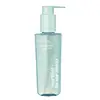What's inside
What's inside
 Key Ingredients
Key Ingredients

No key ingredients
 Benefits
Benefits

 Concerns
Concerns

 Ingredients Side-by-side
Ingredients Side-by-side

Water
Skin ConditioningSodium Lauroyl Glutamate
Panthenol
Skin ConditioningSodium Lauroyl Sarcosinate
CleansingAcrylates/C10-30 Alkyl Acrylate Crosspolymer
Emulsion StabilisingSodium Cocoyl Apple Amino Acids
Skin Conditioning1,2-Hexanediol
Skin ConditioningHydroxyacetophenone
AntioxidantCitric Acid
BufferingHexylene Glycol
EmulsifyingAllantoin
Skin ConditioningCentella Asiatica Leaf Extract
Skin ConditioningTremella Fuciformis Extract
HumectantSodium Hyaluronate
HumectantCetyl Alcohol
EmollientStyrene/Acrylates Copolymer
Tetrasodium Glutamate Diacetate
Water, Sodium Lauroyl Glutamate, Panthenol, Sodium Lauroyl Sarcosinate, Acrylates/C10-30 Alkyl Acrylate Crosspolymer, Sodium Cocoyl Apple Amino Acids, 1,2-Hexanediol, Hydroxyacetophenone, Citric Acid, Hexylene Glycol, Allantoin, Centella Asiatica Leaf Extract, Tremella Fuciformis Extract, Sodium Hyaluronate, Cetyl Alcohol, Styrene/Acrylates Copolymer, Tetrasodium Glutamate Diacetate
Water
Skin ConditioningGlycerin
HumectantCocamidopropyl Betaine
CleansingPropanediol
SolventHydroxypropyl Bis-Hydroxyethyldimonium Chloride
HumectantSodium Methyl Cocoyl Taurate
CleansingSodium Benzoate
MaskingPanthenol
Skin ConditioningTrehalose
HumectantAcrylates/C10-30 Alkyl Acrylate Crosspolymer
Emulsion StabilisingXanthan Gum
EmulsifyingSodium Chloride
MaskingSaccharide Isomerate
HumectantAllantoin
Skin ConditioningPolyquaternium-39
Chlorphenesin
AntimicrobialGlyceryl Polyacrylate
Potassium Hydroxide
BufferingDisodium EDTA
Butylene Glycol
HumectantBetaine
HumectantSodium PCA
HumectantCitric Acid
BufferingSodium Citrate
BufferingSodium Lactate
BufferingPCA
HumectantHouttuynia Cordata Extract
Skin ConditioningSerine
MaskingAlanine
MaskingGlycine
BufferingGlutamic Acid
HumectantLysine Hcl
Skin ConditioningThreonine
Arginine
MaskingPentylene Glycol
Skin ConditioningBeta-Glucan
Skin ConditioningCaprylyl Glycol
EmollientProline
Skin ConditioningWater, Glycerin, Cocamidopropyl Betaine, Propanediol, Hydroxypropyl Bis-Hydroxyethyldimonium Chloride, Sodium Methyl Cocoyl Taurate, Sodium Benzoate, Panthenol, Trehalose, Acrylates/C10-30 Alkyl Acrylate Crosspolymer, Xanthan Gum, Sodium Chloride, Saccharide Isomerate, Allantoin, Polyquaternium-39, Chlorphenesin, Glyceryl Polyacrylate, Potassium Hydroxide, Disodium EDTA, Butylene Glycol, Betaine, Sodium PCA, Citric Acid, Sodium Citrate, Sodium Lactate, PCA, Houttuynia Cordata Extract, Serine, Alanine, Glycine, Glutamic Acid, Lysine Hcl, Threonine, Arginine, Pentylene Glycol, Beta-Glucan, Caprylyl Glycol, Proline
 Reviews
Reviews

Ingredients Explained
These ingredients are found in both products.
Ingredients higher up in an ingredient list are typically present in a larger amount.
Acrylates/C10-30 Alkyl Acrylate Crosspolymer is a synthetic polymer. It is used to thicken and improve the texture of products. Due to its properties, it can prevent water and oil ingredients from separating.
Allantoin is a soothing ingredient known for its protective and moisturizingg properties. Because of this, it is often added to products with strong active ingredients.
Studies show higher concentrations of this ingredient can promote wound healing.
Though it can be derived from the comfrey plant, allantoin is produced synthetically for cosmetic products to ensure purity.
Learn more about AllantoinCitric Acid is an alpha hydroxy acid (AHA) naturally found in citrus fruits like oranges, lemons, and limes.
Like other AHAs, citric acid can exfoliate skin by breaking down the bonds that hold dead skin cells together. This helps reveal smoother and brighter skin underneath.
However, this exfoliating effect only happens at high concentrations (20%) which can be hard to find in cosmetic products.
Due to this, citric acid is usually included in small amounts as a pH adjuster. This helps keep products slightly more acidic and compatible with skin's natural pH.
In skincare formulas, citric acid can:
While it can provide some skin benefits, research shows lactic acid and glycolic acid are generally more effective and less irritating exfoliants.
Most citric acid used in skincare today is made by fermenting sugars (usually from molasses). This synthetic version is identical to the natural citrus form but easier to stabilize and use in formulations.
Read more about some other popular AHA's here:
Learn more about Citric AcidPanthenol is a common ingredient that helps hydrate and soothe the skin. It is found naturally in our skin and hair.
There are two forms of panthenol: D and L.
D-panthenol is also known as dexpanthenol. Most cosmetics use dexpanthenol or a mixture of D and L-panthenol.
Panthenol is famous due to its ability to go deeper into the skin's layers. Using this ingredient has numerous pros (and no cons):
Like hyaluronic acid, panthenol is a humectant. Humectants are able to bind and hold large amounts of water to keep skin hydrated.
This ingredient works well for wound healing. It works by increasing tissue in the wound and helps close open wounds.
Once oxidized, panthenol converts to pantothenic acid. Panthothenic acid is found in all living cells.
This ingredient is also referred to as pro-vitamin B5.
Learn more about PanthenolWater. It's the most common cosmetic ingredient of all. You'll usually see it at the top of ingredient lists, meaning that it makes up the largest part of the product.
So why is it so popular? Water most often acts as a solvent - this means that it helps dissolve other ingredients into the formulation.
You'll also recognize water as that liquid we all need to stay alive. If you see this, drink a glass of water. Stay hydrated!
Learn more about Water